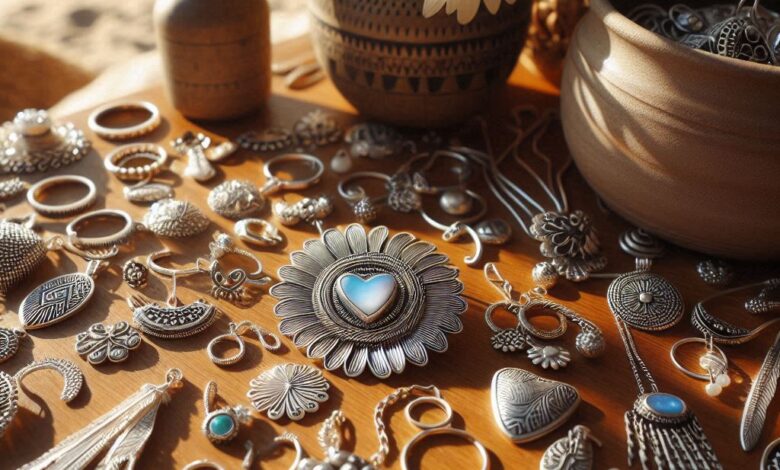From Antiquity to Modernity: The Enduring Appeal of Silver Jewelry

Silver jewelry has captivated humanity for thousands of years, spanning continents, cultures, and civilizations. Its versatility, beauty, and historical significance make it a timeless choice, appealing to both ancient societies and modern fashion enthusiasts. This article explores the journey of silver jewelry from antiquity to the present day, highlighting its enduring appeal and cultural significance.
The Ancient Beginnings of Silver Jewelry
Silver has been valued since ancient times. Archaeological findings suggest that silver was first mined and used around 3000 BCE in regions like Anatolia (modern-day Turkey). The ancient Egyptians, Greeks, and Romans were among the earliest cultures to craft exquisite silver jewelry. For the Egyptians, silver was rarer than gold and often used in royal adornments, symbolizing wealth and divine favor.
The Greeks and Romans expanded the use of silver beyond ornamentation. They utilized silver in coinage, which became a staple of their economies. Silver jewelry from these eras often featured intricate designs and symbols, reflecting the wearer’s status, beliefs, and identity. Greek artisans excelled in filigree work, creating delicate, lace-like patterns, while Roman jewelry often showcased bold designs and gemstones.
Silver in the Middle Ages and Renaissance
During the Middle Ages, silver continued to be a symbol of wealth and power. European nobility and royalty adorned themselves with silver jewelry, which was often set with precious stones. Silver also played a crucial role in religious artifacts and ceremonial objects, reflecting the Church’s influence.
The Renaissance era brought a renewed interest in art, culture, and craftsmanship. Silver jewelry from this period displayed intricate artistry and innovative techniques. Artisans experimented with enameling, engraving, and repoussé (a method of decorating metal by hammering the reverse side). These techniques allowed for more elaborate and detailed designs, marking a high point in the history of silver jewelry.
The Industrial Revolution and Mass Production
The Industrial Revolution in the 18th and 19th centuries transformed the production of silver jewelry. Advances in technology allowed for mass production, making silver jewelry more accessible to the middle class. However, this shift also led to a decline in handcrafted techniques, as machine-made pieces became more common.
Despite this, there was still a market for unique, artisanal silver jewelry. The Arts and Crafts movement of the late 19th century, led by figures like William Morris, sought to revive traditional craftsmanship. 실버도매 This movement emphasized the beauty of handmade objects, and silver jewelry crafted during this time often featured nature-inspired designs and meticulous workmanship.
Modern Silver Jewelry: A Blend of Tradition and Innovation
In the 20th and 21st centuries, silver jewelry has continued to evolve, blending tradition with modernity. The Art Nouveau and Art Deco movements of the early 20th century introduced bold, geometric designs and emphasized the artistic potential of silver. These styles remain popular today, influencing contemporary jewelry designers.
Today, silver jewelry is a staple in fashion, appreciated for its versatility and affordability. It complements both casual and formal attire, making it a favorite choice for everyday wear and special occasions. Modern techniques, such as laser cutting and 3D printing, allow for innovative designs that push the boundaries of traditional craftsmanship.
The Cultural Significance of Silver Jewelry
Silver jewelry’s enduring appeal is also rooted in its cultural significance. In many cultures, silver is believed to have protective and healing properties. For instance, in Hindu culture, silver is associated with the moon and is thought to bring calmness and balance. In Native American traditions, silver jewelry is often inlaid with turquoise and other stones, symbolizing the connection to nature and spiritual beliefs.
Silver jewelry also plays a significant role in rituals and celebrations. In some cultures, silver is given as a gift to mark milestones such as weddings, birthdays, and anniversaries. Its timeless beauty and enduring value make it a cherished heirloom, passed down through generations.
Caring for Silver Jewelry
To maintain the beauty and longevity of silver jewelry, proper care is essential. Silver can tarnish over time due to exposure to air and moisture. Storing silver jewelry in a cool, dry place and using anti-tarnish pouches or cloths can help prevent tarnish. Regular cleaning with a soft cloth and mild soap can also keep silver jewelry looking its best.
The Future of Silver Jewelry
As we move further into the 21st century, the future of silver jewelry looks bright. Sustainable and ethical practices are becoming increasingly important to consumers, and the jewelry industry is responding. Recycled silver and fair-trade practices are gaining traction, ensuring that the beauty of silver jewelry does not come at the expense of the environment or human rights.
Innovative designs and new technologies will continue to shape the future of silver jewelry. Designers are experimenting with mixed metals, incorporating silver with gold, platinum, and alternative materials like resin and wood. This fusion of materials and styles reflects the dynamic and ever-evolving nature of fashion.
Conclusion
From antiquity to modernity, the appeal of silver jewelry remains strong. Its historical significance, cultural value, and timeless beauty make it a cherished adornment across the ages. Whether crafted by ancient artisans or contemporary designers, silver jewelry continues to captivate and inspire. As we look to the future, silver’s enduring allure promises to shine brightly for generations to come.




